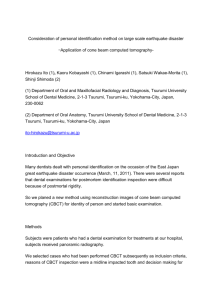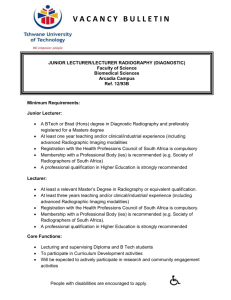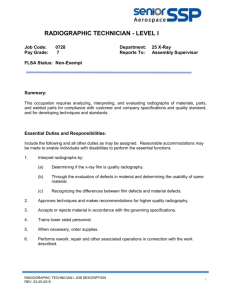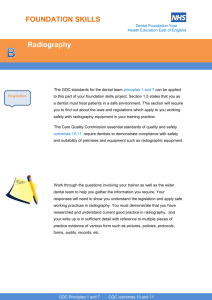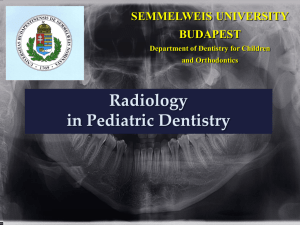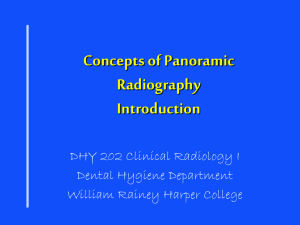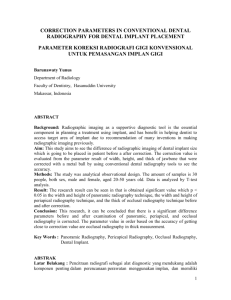DENTAL RADIOGRAPHY
advertisement
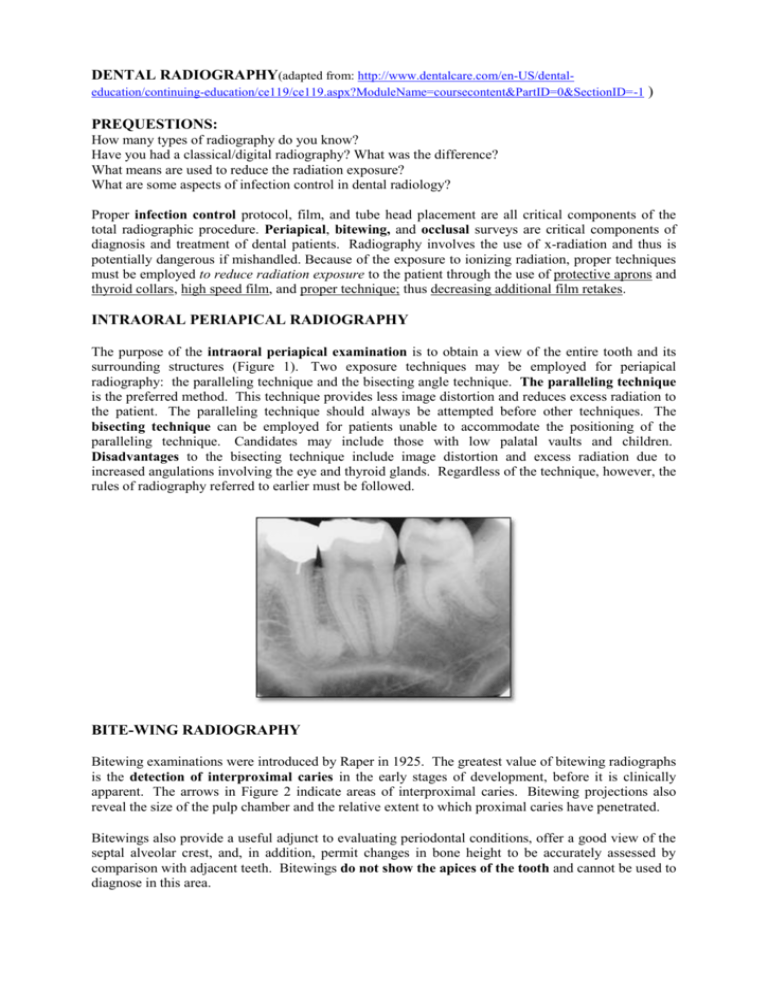
DENTAL RADIOGRAPHY(adapted from: http://www.dentalcare.com/en-US/dentaleducation/continuing-education/ce119/ce119.aspx?ModuleName=coursecontent&PartID=0&SectionID=-1 ) PREQUESTIONS: How many types of radiography do you know? Have you had a classical/digital radiography? What was the difference? What means are used to reduce the radiation exposure? What are some aspects of infection control in dental radiology? Proper infection control protocol, film, and tube head placement are all critical components of the total radiographic procedure. Periapical, bitewing, and occlusal surveys are critical components of diagnosis and treatment of dental patients. Radiography involves the use of x-radiation and thus is potentially dangerous if mishandled. Because of the exposure to ionizing radiation, proper techniques must be employed to reduce radiation exposure to the patient through the use of protective aprons and thyroid collars, high speed film, and proper technique; thus decreasing additional film retakes. INTRAORAL PERIAPICAL RADIOGRAPHY The purpose of the intraoral periapical examination is to obtain a view of the entire tooth and its surrounding structures (Figure 1). Two exposure techniques may be employed for periapical radiography: the paralleling technique and the bisecting angle technique. The paralleling technique is the preferred method. This technique provides less image distortion and reduces excess radiation to the patient. The paralleling technique should always be attempted before other techniques. The bisecting technique can be employed for patients unable to accommodate the positioning of the paralleling technique. Candidates may include those with low palatal vaults and children. Disadvantages to the bisecting technique include image distortion and excess radiation due to increased angulations involving the eye and thyroid glands. Regardless of the technique, however, the rules of radiography referred to earlier must be followed. BITE-WING RADIOGRAPHY Bitewing examinations were introduced by Raper in 1925. The greatest value of bitewing radiographs is the detection of interproximal caries in the early stages of development, before it is clinically apparent. The arrows in Figure 2 indicate areas of interproximal caries. Bitewing projections also reveal the size of the pulp chamber and the relative extent to which proximal caries have penetrated. Bitewings also provide a useful adjunct to evaluating periodontal conditions, offer a good view of the septal alveolar crest, and, in addition, permit changes in bone height to be accurately assessed by comparison with adjacent teeth. Bitewings do not show the apices of the tooth and cannot be used to diagnose in this area. OCCLUSAL RADIOGRAPHS Occlusal radiography is a supplementary radiographic examination designed to provide a more extensive view of the maxilla and mandible (Figure 3). The occlusal radiograph is very useful in determining the buccolingual extension of pathologic conditions, and provides additional information as to the extent and displacement of fractures of the mandible and maxilla. Occlusal films also aid in localizing unerupted teeth, retained roots, foreign bodies, and calculi in the submandibular and sublingual salivary glands and ducts. It should be noted that when imaging soft tissues exposure time needs to be appropriately reduced. ORTHOPANTOMOGRAPHY (OPT) The panoramic exam allows the study of all teeth pathology as well as TM joint & mandibule. A panoramic radiograph (also termed panorexTM, dental panoramic radiograph, orthopantomogram or orthopantomographTM, and sometimes abbreviated as PAN, DPR, OPT or OPG), is a panoramic scanning dental X-ray of the upper and lower jaw. It shows a two-dimensional view of a half-circle from ear to ear. An OPG relies on tomography i.e. images of specific radiographic planes are taken to make up the larger panoramic image where the maxilla and mandible are in the focal trough and the structures, superficial and deep to the trough, are blurred. When doing it, patients may be asked to remove jewellery, glasses, and any metal objects that may obscure the images such as earrings, tongue rings etc. Patients will be asked to stand facing the machine with their chin resting on a small platform and to bite gently on a small sterile mouth piece to prevent movement of the head. The x-ray image is acquired in only a few seconds passing in front of the face from one side of the body to the other. During this time it is important that patients remain as still as possible whilst the image is being taken to ensure that no blurring occurs. The digital image is instantly displayed for the Medical Imaging Technologist to evaluate. (panoramic radiography machine) Principal advantage of panoramic images Broad coverage of facial bones and teeth Low patient radiation dose Convenience of examination for the patient (films need not be placed inside the mouth) Ability to be used in patients who cannot open the mouth or when the opening is restricted e.g.: due to trismus Short time required for making the image. Easy to store compared to the large set of intra oral x-rays which are typically used DIGITAL RADIOLOGY Digital imaging was introduced into dentistry in 1987. Digital sensors are used instead of x-ray film. Sensors can be wired or wireless depending on the system used (Figures below). Sensors and tube head placement are the same for digital imaging as film and tube head placement is for traditional radiology. Most standard radiographic machines can be converted to acquire digital images. Digital imaging still uses ionizing radiation, and therefore, before any radiographs are exposed, the patient must be protected with a protective apron and thyroid collar. The apron must be properly placed to avoid interference with the radiographic exposure. The advantages of digital radiology are decreased exposure time to the patient, elimination of darkroom processing time and exposure to processing chemicals. Digital imaging has environmental advantages with reduced waste production and also paper and film consumption. Immediate viewing, and ability to easily and cost effectively transmit directly to third party facilities or affiliating dental offices are added advantages. Additional computerized advantages include the ability to enhance the image for viewing. Once an image is in the computer, brightness and contrast and image reversal can be enhanced for optimal viewing of tissue and bone levels. The radiographic image can be rotated, enlarged, and magnified to enhance details for diagnosis and patient education. The main disadvantages are substantial start up costs including machinery and operatory computer technology, and compatibility with other software program and RAM capacity. Considerations must also be noted that although your office may utilize digital radiography, other facilities may not and the transfer of images between them could be more difficult.The digital sensors are considered a disadvantage by some operators as they are thicker than film and more difficult to orient in the oral cavity. Also, the sensors cannot be sterilized and must be protected by a barrier before handling and placement. INFECTION CONTROL The CDC published guidelines in 2003 that specifically relate to dental radiography safety and infection control. Operator safety includes wearing all personal protective equipment (PPE) – gloves, mask, eyewear, and protective clothing – to prevent contamination from blood and other bodily fluids that can spatter. Patient protection includes the use of a protective (usually lead lined) apron that must be large enough to cover the sitting patient from neck to knees. The use of a protective thyroid collar is also recommended to reduce exposure to scatter radiation. The apron and collar must be disinfected after each use. Before any films can be exposed, the operator must understand the infection control protocols. Potential cross contamination between patient, equipment, and environmental surfaces can happen before, during, and after film exposure. The use of barriers on machinery and electrical switches are necessary to prevent transmission as they cannot be easily disinfected or could receive an electrical short from a chemical spray. Each office must establish a protocol from preparation, to exposure, to processing to maintain the aseptic chain. POST-QUESTIONS 1.What types of dental radiography do you know? 2.What means are employed in order to reduce radiation exposure? 3. What is the purpose of intraoral periapical examination? 4. What are the two exposure techniques that may be employed for periapical radiography? 5. In what cases is the bisecting technique employed? 6. What are the disadvantages to the bisecting technique? 7. What is the greatest value of bitewing radiographs 8. Mention one shortcoming of bitewings. 9. What conditions are indications for occlusal radiograph? 10. What are some advantages of panoramic images? 11. Mention some advantages/disadvantages of digital radiography 12. What is PPE? 13. What does patient protection consist of ?

